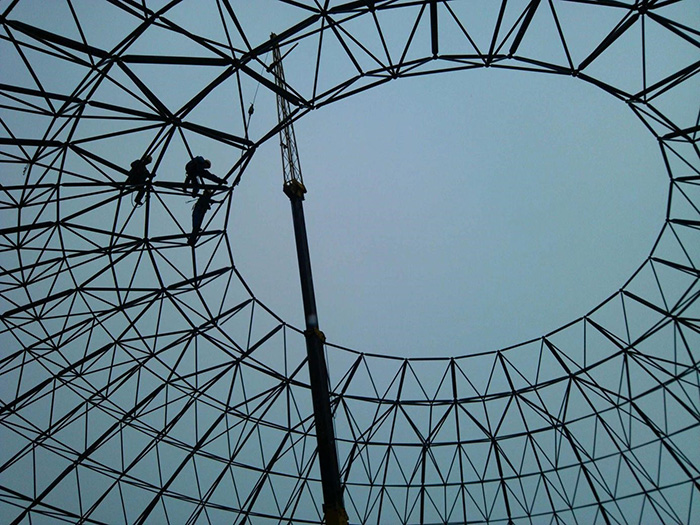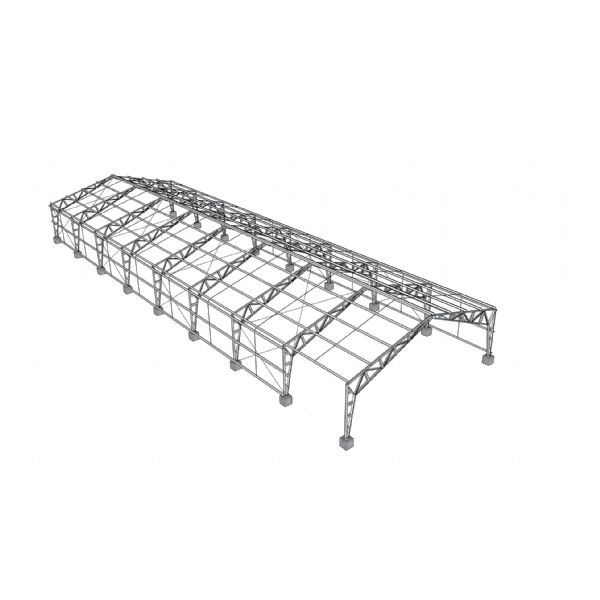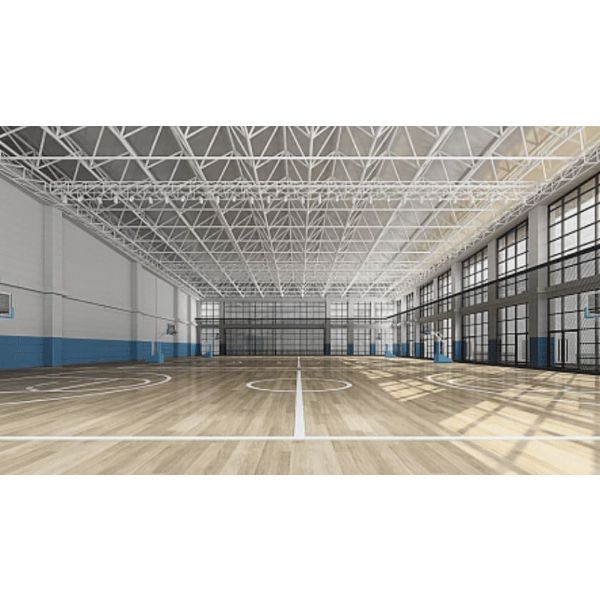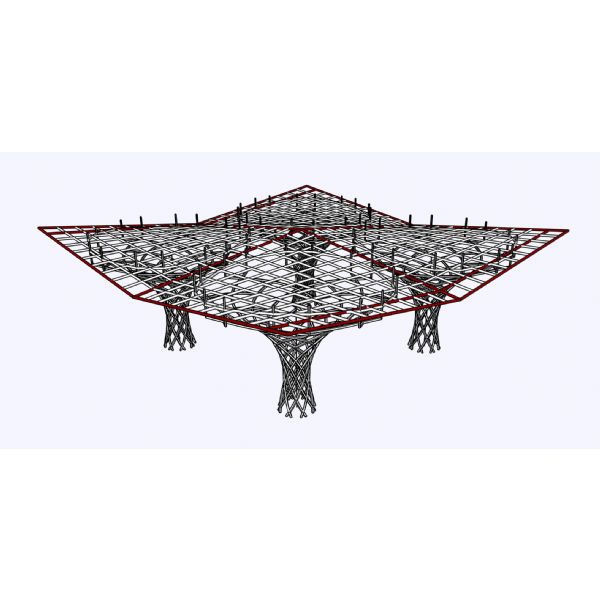What I find most thrilling in space truss construction is how it’s solving real issues. Were you ever in a huge stadium and there isn’t a column in the way to obstruct the view? That’s space truss engineering powered by tech in construction 2025. Space truss systems are changing everything from sports stadiums to office buildings and no one even realizes the incredible engineering going on above.
What Are Space Truss Structures?
Let me put this in simpler terms. Take the strongest shape in nature – a plain old triangle – and extend that concept to three dimensions. That’s what space truss structures are essentially doing, except that they are doing it with incredible precision and mathematical beauty.
These are not grandfather’s roof trusses. These are three-dimensional systems of today with each and every member of a mission, all working together in harmony in an exquisitely choreographed ballet. Each is pushing or pulling, but never bending – and that is gold, engineering gold because it provides maximum strength at minimum weight.
This is what blows my mind about modern design: Tech in construction 2025 has given us code that can crunch through thousands of different configurations in the time it takes me to pour a cup of morning coffee. I remember engineers taking weeks to painstakingly do load paths by hand. Now? The computer does the complex math for us and we get to focus on solving the problems creatively.
The geometrical potential is endless. You’ve got your standard double-layer lattices that look like geometer spider webs, pyramid modules that stack like a box of Lego blocks, and these wild curved surfaces that are controlled by math equations I couldn’t crack in college. The choice most often has to do with what you’re trying to achieve – span length, visual impact, or structural efficiency.
But the exciting thing is this: modern space trusses are no longer passive systems. I’ve worked on projects where truss members respond to variations in temperature or loading conditions. The building essentially has a nervous system now, if you will.
How Space Truss Structures Work
Magic in the math, but let me tell you about it in a manner that will not make you doze off. When you prestress a space truss, these loads don’t just disappear into thin air – they get passed on through the system in the same manner that water will run downhill along the path of least resistance. Only there is not one, but dozens or hundreds of paths that it will take.
Load Distribution Mechanisms
This redundancy is what generates such reliability in space trusses. I’ve been in a building where you can remove a section of members and the building will remain upright because the loads will simply redirect themselves to the foundation. It’s plan B for plan B.
Tech in construction 2025 has totally transformed how we analyze these load paths. AI software can now model in real-time how forces will flow through intricate shapes. I’ve been working on a project lately where the software was optimizing the structure in real-time as we altered the design. It was like having a structural engineering genius over my shoulder 24/7.
Computer programs that we utilize today were science fiction when I began practice. They are able to simulate anything from a wind storm to an earthquake and tell us precisely how our structures will react before we even start digging.
Connection Systems and Joint Technology
And so, if the space truss members are muscles, then connections have to be the joints. And as it is with human joints, they would have to be wonderfully complicated to be able to allow for all those complicated forces from all directions.
I’ve witnessed connection technology evolve a great distance from plain old bolted fittings to these precision machined marvels that look like they’re ready to take flight on a spaceship. More advanced models almost make connections for you – I’m talking about connections with sensors built into them that can warn you if they’re tightened properly or if something is amiss in the form of stress. For precision-engineered steel components that meet the exacting standards of space truss construction, Prefabricated modular steel structures designed for complex structural applications.
The truly awesome things are being done with robot manufacturing. I visited a store recently where robots were robotically welding joints tighter than most humans could possibly do by hand. This is where tech in construction 2025 really shows its precision capabilities. Building 2025 technology is making such precision parts cheaper and more accessible than ever.
Material Optimization and Selection
Materials science has come a long way from plain steel and aluminum. We’re working with high-strength alloys today that our forebears could hardly have dreamed of. The real revolution, however, is in the way that we select those materials.
Computer software can also examine thousands of permutations of materials, factoring in everything from cost and longevity to availability locally and environmental sustainability. Having an ever-on materials wizard that would remember every spec sheet ever designed would be great.
Major Applications and Uses of Space Truss Structures
Now I’ll enlighten you where space trusses really shine, because uses are a heck of a lot more diverse than most people realize.
Sports Facilities and Wide-Span Structures
Sports stadiums are the first, most prominent, and an obvious example, and one can easily see why. When you’re spanning 300+ meters and you just cannot have columns anywhere, space trusses become the only feasible option. But there’s more to it than the span – it’s about creating these wonderful works of architecture that become city icons.
I was building an arena with an open and close space truss roof based on weather. The engineering involved in making that possible contained more moving parts than most people see in a lifetime. Smart system integration allowed the structure to automatically adapt to wind, rain, or even the volume of crowd noise.
Stadiums nowadays are no longer buildings – they are entertainment complexes with inbuilt lighting, sound, and air conditioning systems all incorporated within the truss system. Technology 2025 allows us to encapsulate all such technology inside the building and give us clean lines of vision with optimum functionality still preserved.
Commercial and Office Buildings
Office buildings are not the glamour in relation to stadiums, but they are where the majority of the most innovative space truss building is being done. Having the ability to provide entirely flexible floor plates with no columns is a great freedom to offer tenants in order to allow them to configure their space in any way that they would like.
I’ve been in office buildings where you can rearrange the floor layout overnight since the space truss system is bearing everything above it. There are no load-bearing walls to mention, which is as much end-use flexibility as possible – something that, with tech in construction 2025, has become immensely valuable in our changing work environment.
Industrial and Manufacturing Facilities
Factory structures place unique requirements that are readily satisfied by space trusses. The structures need to have extremely large clear spans to provide space for machines but, at the same time, be strong enough to support heavy crane loads, machine vibration, and the capability to handle changing manufacturing processes.
Space trusses’ three-dimensional load distribution enables you to suspend heavy equipment anywhere within the building without having to look for a beam from which to hang it. The building can transfer those concentrated loads to the entire system.
Transportation Infrastructure
Airport terminals, train stations, and transit buildings are a natural application for space truss technology. These buildings must accommodate large volumes of human beings while providing inspiring architectural space that minimizes the anxiety of traveling.
Tech in construction 2025 has turned transport buildings into smart buildings that can monitor passenger traffic, manage environmental conditions, and even provide real-time information via display systems incorporated into the building’s structural system itself.
Specialty Structures and Unique Applications
That is where it gets truly exciting. Space trusses are the next-generation buildings that push the boundaries of what we initially thought possible. I have been involved in designing art installation pieces, research facilities, and cultural facilities with the use of space truss technology to create whole new types of architecture.
This capability to form complicated curved surfaces without any compromise in structural strength presents possibilities that architects have only recently started to investigate. Quite literally, we’re constructing impossible shapes otherwise achievable with the help of high-technology computation as well as space truss technology.
The Utilization of Technology in Modern Space Truss Construction
The computer age has completely changed how we need to go about space truss design, and quite honestly, we are just beginning to scratch the surface of what can be done. Tech in construction 2025 is opening doors we never thought possible.
Advanced Design and Analysis Software
Nowadays the design software is a crystal ball. I can preload unbelievably complicated structures, run thousands of loads, and precisely know how the building will react in any situation. Building Information Modeling (BIM) is our new language – architects, engineers, and contractors all speak from the same three-dimensional model. According to Market Size, Share, Trends 2030. The global Building Information Modeling market is poised to reach $14.8 billion by 2029, growing at a CAGR of 13.1%
Yet the magic happens with artificial intelligence integration. AI software is now able to do the job of truss configuration optimization by itself, considering anything from material cost to construction complexity to long-term performance. It’s like having round-the-clock master engineer teams working day and night to devise the perfect solution.
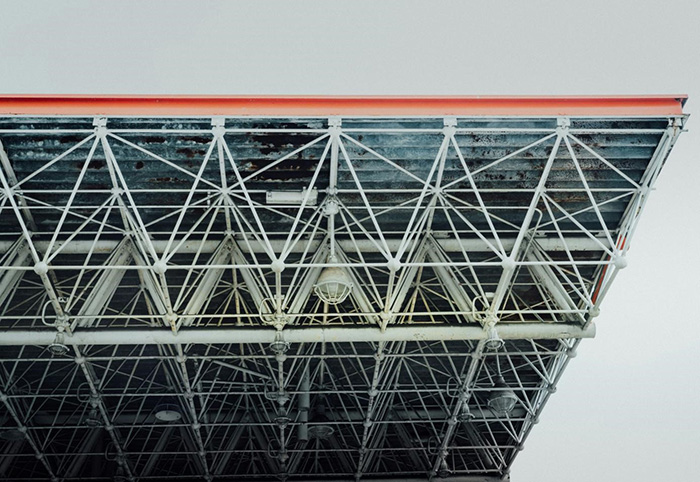
Digital Fabrication and Precision Manufacturing
The fabrication technology is so advanced it amazes me in its accuracy. The CNC cutting and welding machines can create components with tolerances in terms of fractions of millimeters. This kind of precision is needed in space truss structures where everything must fit exactly into place.
Robotic assembly is the norm these days for challenging work. I have watched robots weld seams with accuracy far greater than human hands can achieve, and churn out perfect quality throughout a whole job. 3D printing is starting to join in the fun as well, especially for those completely insane complicated connection pieces that’d be all but impossible to make the traditional way.
Construction Technology and Assembly Methods
2025 construction technology has also transformed the way we actually build such complex structures. Complex crane systems can drop massive truss sections down to the ground in millimeter accuracy, and virtual reality systems enable construction teams to rehearse complex sequence of assembly without ever needing to venture out to site.
I like to watch construction workers use augmented reality headsets and see precisely where a certain piece fits. You have a kind of X-ray vision and see the completed building since you are still building it. These technologies have eliminated a lot of mistakes in construction and added a great amount of safety to complex projects.
Design Principles and Engineering Considerations
Space truss structural design is an art, a science, and a guesswork. But Construction Technology 2025 has enabled the guesswork to be much better informed.
Geometric Optimization and Configuration Selection
Selecting an appropriate geometry for a space truss is more of an exercise of solving a three-dimensional puzzle with hundreds of right solutions. Our parametric design software nowadays allows us to screen thousands of solutions in minutes, but again, ultimately, it always comes down to engineering judgment and project-specific need.
They usually do regular geometric shapes since those are simpler to construct and create, yet at times you must have unique geometries so that you can meet specific design objectives. The challenge is in locating that golden ratio between constructability and structural efficiency.
Load Path Analysis and Redundancy Design
Computing how loads travel through a space truss is a task that demands high-level analysis software that can follow lines of force through intricate three-dimensional shapes. The art, though, lies in the design of redundancy – in developing a structure that is robust enough to survive anomalies like unexpected loads or even the failure of individual members.
Dynamic Response and Vibration Control
Long-span lightweight structures are prone to dynamic loading due to wind or traffic loading. Recent analysis techniques enable us to analyze and predict such a response and add appropriate control action wherever required.
Connection Detail Development and Connection Design
Space truss connections have to address complex three-dimensional force systems, e.g., geometric accuracy. Finite element analysis is being used in connection design today to guarantee optimum performance and durability.
Advantages and Benefits of Space Truss Systems
A generation or more of experience with space trusses hasn’t dulled my amazement at what they can do.
Structural Efficiency and Less Material
Space truss systems are very efficient. You can normally achieve the same structural performance with 30-40% less steel than with conventional systems in most applications. Technology optimization takes this efficiency even further by optimizing all of the member sizes and connection details. Our steel structure products are specifically engineered to maximize structural efficiency while minimizing material usage in space truss applications.
The environmental benefits are also significant. Reduced material means less embodied energy and less transportation requirement. Life cycle analysis techniques allow us to quantify these benefits to green building rating systems.
Architectural Flexibility and Design Freedom
Space trusses provide designers with a great degree of freedom to create complex configurations that would be impossible to achieve through the use of conventional structural systems. The provision to create large column-free spaces is particularly beneficial in open space design in buildings.
Perforation of building services by truss construction realizes functional efficiency and powerful visual expression. HVAC, electrical, and communication systems are routed through the three-dimensional space in a cost-effective way.
Construction Efficiency and Quality Control
Space truss construction is strongly supported by the efficiency achieved through prefabrication. Factory-made units offer guaranteed quality with less on-site construction time.
Construction technology 2025 is a computer project management software that simplifies the delivery of units and assembly sequencing, minimizes construction delays, and streamlines coordination with trade contractors.
Challenges and Future Directions
Despite all of this, space truss construction also still poses some challenges that must be given very serious consideration.
Design Sophistication and Analysis Requirements
Three-dimensional complexity of space truss systems requires programs of analysis and engineering staff that are highly sophisticated. To analyze the impact of interaction among members, joints, and support systems, highly sophisticated software and laborious engineering expertise are required.
Construction Complications and Site Logistics
Space truss structure assembly requires planning and sophisticated equipment. Three-dimensional structures imply that assembly sequences may be complex, and site logistics planning is a success factor for a project.
Economic Feasibility and Cost Minimization
The economic viability of space truss systems depends on a compromise between structural efficiency and construction complexity. Construction 2025 is rendering this trade-off increasingly sophisticated, but projects still rely on astute cost studies to ascertain feasibility.
Incorporating Technology into the Future
New technologies offer even greater possibilities with what can be done with space truss systems. Artificial intelligence, robotics, and smart materials are opening up new possibilities for design, construction, and operation of intricate structures.
Conclusion
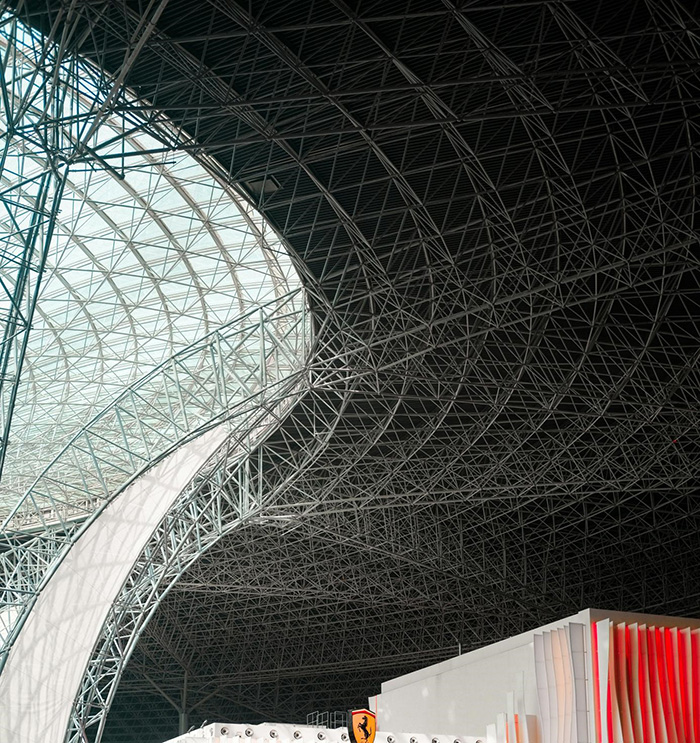
Space truss construction is among the most thrilling developments in modern construction. The meeting of centuries-old construction technology and structural engineering art 2025 has made possible what a few years ago appeared distant possibilities.
From stadium titans to new office skyscrapers, space truss systems are enabling architects and engineers to create functionally improved and aesthetically superior buildings. Refinement in design software, manufacturing technology, and construction systems maintenance are making these advanced systems economical.
Space truss construction has a very promising future. As we move forward with the building technology of 2025, we will see more and more of these systems as a key factor in achieving the sustainable, productive, and innovative structures the world needs. Whether you are an architect standing at the portal to opening up new possibilities in design, an engineer seeking solutions of efficiency, or a contractor searching for means of maximizing project outcomes, space truss systems offer significant advantages certainly worth examining in detail.
For those who would like to learn more about the art of structural engineering or stay current with new developments in construction technology, space truss structures represent a fascinating combination of old-fashioned engineering creativity and cutting-edge technological innovation. As we move forward and push the boundaries of what is achievable in construction, these developing revolutionary structural systems will continue to shape the built environment of the future.
Ready to bring your space truss project to life? At XTD Steel Structure, we specialize in precision steel fabrication for complex structural systems. Whether you’re designing the next iconic stadium or innovative commercial space, our team has the expertise and technology to make it happen. Contact us and discover how we can support your next space truss construction project.

